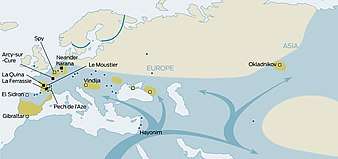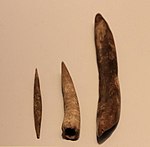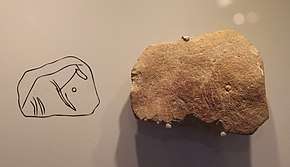HaYonim Cave
HaYonim Cave (Hebrew: מערת היונים, Me'arat HaYonim, lit. Cave of the Pigeons) is a cave located in a limestone bluff about 250 meters above modern sea level, in the Upper Galilee, Israel.
מערת היונים | |
 Location in Israel  HaYonim Cave (Israel) | |
| Location | Upper Galilee |
|---|---|
| Region | Israel |
| Coordinates | 32°55′12.32″N 35°13′5.75″E |
| History | |
| Periods | Middle Paleolithic |
| Cultures | Mousterian |

History
The site had substantial occupation during the Middle Paleolithic Mousterian period, from 250,000 years ago to 100,000 years ago, and later, during the Neolithic period and the Natufian culture around 12,000 years ago.[1]
The Mousterian occupation of the cave included Levallois debitage and early Middle Paleolithic blade technology, as well as a series of hearths.
In Hayonim were also found wall carvings depicting symbolic shapes and animals, such a running horse dated to between 40,000-18,500 BP, possibly to the Aurignacian circa 28,000 BP, and now visible in the Israel Museum.[2][3][4][5][6] This is considered as the first art object found within the context of the Levantine Upper Paleolithic.[6]
The Natufian occupation of the cave featured circular rooms with prepared floors, with a thick midden of lithics, groundstone objects, and worked bone. There were several hearths, and single graves located in abandoned rooms or outside inhabited rooms.
 Flint end scraper with horn handle for working wood or leather, Late Stone Age, Hayonim Cave, 50000-22000 BP
Flint end scraper with horn handle for working wood or leather, Late Stone Age, Hayonim Cave, 50000-22000 BP Aurignacian Culture incised animal bones, Hayonim Cave, 28000 BP.
Aurignacian Culture incised animal bones, Hayonim Cave, 28000 BP. Aurignacian Culture bone tools (needdle, points and tools for punching holes), Hayonim Cave, 30000 BP.
Aurignacian Culture bone tools (needdle, points and tools for punching holes), Hayonim Cave, 30000 BP.
 Bovine-rib dagger, Hayonim Cave, Natufian Culture, 12500-9500 BC.
Bovine-rib dagger, Hayonim Cave, Natufian Culture, 12500-9500 BC. Woman's pelvis decorated with fox teeth, Hayonim Cave, Natufian Culture, 12500-9500 BC.
Woman's pelvis decorated with fox teeth, Hayonim Cave, Natufian Culture, 12500-9500 BC.
See also
- List of caves in Israel
- Archaeology of Israel
References
- 'Quantitative Phytolith Study of Hearths from the Natufian and Middle Paleolithic Levels of Hayonim Cave, (Galilee, Israel)' Journal of Archaeological Science 30, pages 461-480., Albert, Rosa M., Ofer Bar-Yosef, Liliane Meignen, and Steve Weiner 2003
- Yiśraʼel (Jerusalem), Muzeʼon; Museum (Jerusalem), Israel (1986). Treasures of the Holy Land: Ancient Art from the Israel Museum. Metropolitan Museum of Art. p. 29. ISBN 9780870994708.
- "Hayonim horse". museums.gov.il.
- "Horse from Hayonim Cave, Israel, 30,000 years" in Israel Museum Studies in Archaeology. Samuel Bronfman Biblical and Archaeological Museum of the Israel Museum. 2002. p. 10.
- "Sketch on a pebble found in the Hayonim cave (Israel, Aurignacian period, between c. 43 000 and c. 23 000 BP)" Pigeaud, Romain (2002). D'os, d'images et de mots: contribution à la réflexion sur les sources de l'histoire des connaissances zoologiques ; journée d'étude Université de Liège, 17 mars 2001 (in French). Université de Liège. p. 7.
- Bar-Yosef, Ofer; Belfer-Cohen, Anna (1981). The Aurignacian at Hayonim Cave. pp. 35–36.
- Yiśraʼel (Jerusalem), Muzeʼon; Museum (Jerusalem), Israel (1986). Treasures of the Holy Land: Ancient Art from the Israel Museum. Metropolitan Museum of Art. p. 29. ISBN 9780870994708.
- "Horse from Hayonim Cave, Israel, 30,000 years" in Israel Museum Studies in Archaeology. Samuel Bronfman Biblical and Archaeological Museum of the Israel Museum. 2002. p. 10.
- "Hayonim horse". museums.gov.il.